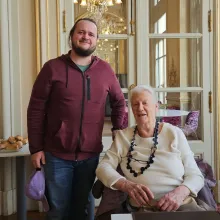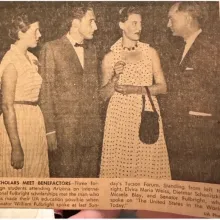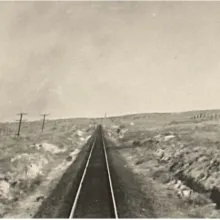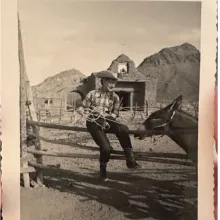The Lifelong Impact of a Fellowship: Reflections on UArizona from the Oldest Living Fulbright France Alumni as told to a Current Fulbright Fellow

Figure 1: Author and current Fulbright France Fellow Josh Barbre with Micaela Thorup (née Blay)
Photo credit: Josh Barbre
2023 was the 75th anniversary of the Fulbright France program. Members of the Fulbright administration, French and American ambassadors, current Fellows, and alumni attended the final celebration in November. As I walked through the celebration, I overheard someone mention the University of Arizona, my home institution. The woman, surrounded by her daughters, visibly displayed fondness when discussing the city in our Sonoran Desert. Micaela Thorup (née Blay) is the oldest-living Fulbright France Alumna. She spent her fellowship at the University of Arizona in the 1953-54 school year as a graduate student. Over a series of conversations and emails, Micaela shared stories of her journey. Elements of discovery, connections, and future career growth have proven constants through the seventy-five years of Fulbright France.

Figure 2: Micaela meeting Senator Fulbright
Photo credit: Josh Barbre
Our conversations began because of our shared love of the University of Arizona. Micaela learned about the life-changing opportunity from Senator Fulbright himself. During the 1950s, very few French students went to the US, and even fewer journeyed to the states emblematic of the American West; Micaela was one of the first to do so, and the Fulbright program made this compelling experience of global exchange possible.
From France to the Sonoran Desert

Figure 3: Micaela's view as she arrived in Arizona
Photo credit: Josh Barbre
Micaela’s journey to Tucson started in Cannes, France. She recalls a general strike in France, and her parents had to drive her, with her trunk, to Cherbourg to board the RMS Queen Elizabeth to sail to New York. During her four days at sea, she was accompanied by the other French Fulbrighters with whom she maintained contact even after she returned home. After landing in New York, she explored the area before boarding a train from New York to Tucson. The train ride lasted another four days. When she arrived in Tucson, a foreign student advisor named Jerry met her at the train. She curtseyed, as was customary for her back in France, and he then took her to a party for international students at the University of Arizona before she went to her shared room at Maricopa dormitory. While Micaela’s journey was much more involved than my nine-hour direct flight to Paris, she was able to traverse almost the entirety of the United States even prior to her arrival in her new desert home.
La vie d’un chat sauvage (The Life of a Wildcat)

Figure 4: Micaela's Christmas card 1953
Photo credit: Josh Barbre
Throughout our conversations, Micaela shared artifacts and anecdotes with me about her life as a student, including her yearbook. Many professors, classmates, and staff members signed it for her, including one from Marvin “Swede” Johnson that read: “To our most famous French Student, Swede Johnson.” Among her photographic souvenirs is a Christmas card in which she sports cowgirl attire in a striking ranch setting— a glamorized insertion into the Wild West.
In her personal life, Micaela used music to connect with her peers and to gain a better command of the language. In addition to her participation in the University of Arizona choir, she also performed twice at the International Students Club Variety Show. Her solo performance included songs by Edith Piaf, and her group performance featured French folk songs while dressed in costumes from Nice and Cannes. Micaela credits these performances with giving her self-confidence; she claims that she thought that she was shy, but after those performances felt like a star. She channeled her new-found confidence into her rewarding career in cultural exchange.
Fond Memories

Figure 5: Micaela performing Edith Piaf 1954
Photo Credit: Josh Barbre
Micaela’s trip to Arizona became an agent of change for her. The discovery of the United States and the beauty of the surrounding desert allowed her to go through a process of self-discovery through experience, knowledge, and personality. She credits her trip to Arizona as the beginning of her work for global connections and of her interest to be that agent of change.
Would she do it again? Absolutely. Micaela states that she would probably go back to Arizona. “It was so different. You know, If I had gone to places like Yale or Harvard, they were more like the European systems I already knew.” Seventy years later, at age ninety-two, Micaela still cherishes memories of her time in Tucson; she gives credit to the Fulbright program, to the University of Arizona, and to the people of Tucson for the impact they had on her personal growth and successful professional career.
If you would like to reach out to Micaela Thorup, her contact email is micathor@orange.fr.

